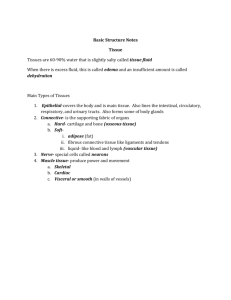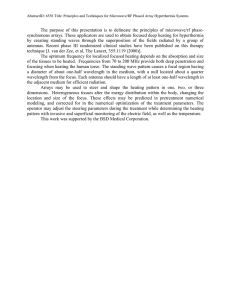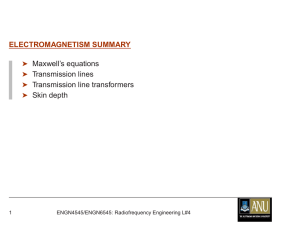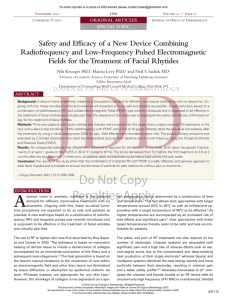A Model of Noninvasive Radiofrequency Tissue Heating
advertisement
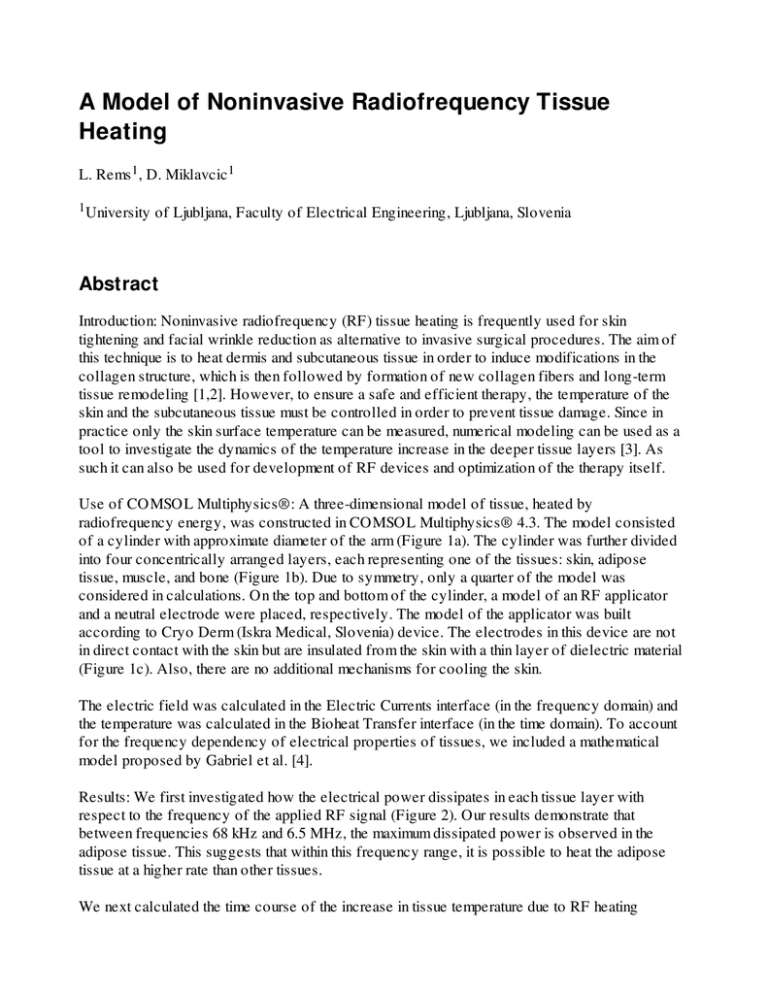
A Model of Noninvasive Radiofrequency Tissue Heating L. Rems 1 , D. Miklavcic 1 1 University of Ljubljana, Faculty of Electrical Engineering, Ljubljana, Slovenia Abstract Introduction: Noninvasive radiofrequency (RF) tissue heating is frequently used for skin tightening and facial wrinkle reduction as alternative to invasive surgical procedures. The aim of this technique is to heat dermis and subcutaneous tissue in order to induce modifications in the collagen structure, which is then followed by formation of new collagen fibers and long-term tissue remodeling [1,2]. However, to ensure a safe and efficient therapy, the temperature of the skin and the subcutaneous tissue must be controlled in order to prevent tissue damage. Since in practice only the skin surface temperature can be measured, numerical modeling can be used as a tool to investigate the dynamics of the temperature increase in the deeper tissue layers [3]. As such it can also be used for development of RF devices and optimization of the therapy itself. Use of COMSOL Multiphysics®: A three-dimensional model of tissue, heated by radiofrequency energy, was constructed in COMSOL Multiphysics® 4.3. The model consisted of a cylinder with approximate diameter of the arm (Figure 1a). The cylinder was further divided into four concentrically arranged layers, each representing one of the tissues: skin, adipose tissue, muscle, and bone (Figure 1b). Due to symmetry, only a quarter of the model was considered in calculations. On the top and bottom of the cylinder, a model of an RF applicator and a neutral electrode were placed, respectively. The model of the applicator was built according to Cryo Derm (Iskra Medical, Slovenia) device. The electrodes in this device are not in direct contact with the skin but are insulated from the skin with a thin layer of dielectric material (Figure 1c). Also, there are no additional mechanisms for cooling the skin. The electric field was calculated in the Electric Currents interface (in the frequency domain) and the temperature was calculated in the Bioheat Transfer interface (in the time domain). To account for the frequency dependency of electrical properties of tissues, we included a mathematical model proposed by Gabriel et al. [4]. Results: We first investigated how the electrical power dissipates in each tissue layer with respect to the frequency of the applied RF signal (Figure 2). Our results demonstrate that between frequencies 68 kHz and 6.5 MHz, the maximum dissipated power is observed in the adipose tissue. This suggests that within this frequency range, it is possible to heat the adipose tissue at a higher rate than other tissues. We next calculated the time course of the increase in tissue temperature due to RF heating (Figure 3 and 4). The frequency of the RF signal was set to 1 MHz, and the voltage on the active electrode was 1000 V. The maximum temperature is indeed observed in the adipose tissue, whereas the temperature at the skin surface is approximately 1-2°C lower. Conclusion: RF energy induces targeted heating of adipose tissue for a relatively wide frequency range of the applied RF signal. Using our model we can develop optimal heating protocol to ensure safe and efficient RF therapy. Reference 1. Neil S. Sadick, Yuriko Makino, Selective electro-thermolysis in aesthetic medicine: A review, Lasers Surg. Med., 34, 91–97 (2004). 2. Richard Fitzpatrick et al., Multicenter study of noninvasive radiofrequency for periorbital tissue tightening, Lasers Surg. Med., 33, 232–242 (2003). 3. Joel N. Jimenez Lozano et al., Effect of fibrous septa in radiofrequency heating of cutaneous and subcutaneous tissues: Computational study, Lasers Surg. Med., 45, 326–338 (2013). 4. Sami Gabriel et al., The dielectric properties of biological tissues: III. Parametric models for the dielectric spectrum of tissues, Phys. Med. Biol., 41, 2271–2293 (1996). Figures used in the abstract Figure 1: Tissue model. (a) 3D view. (b) Front view. (c) Model of RF applicator. The surfaces colored in blue are modeled as electrodes by assigning them an electric potential. Figure 2: Frequency dependency of the maximum dissipated power in separate tissue layers of the model. Vertical lines mark the frequencies for which dissipated power in the adipose tissue is the highest. Figure 3: Temperature in separate tissue layers along a line beneath the applicator at different times after applying RF energy (1 MHz, 1000 V). Ambient temperature was 25°C. Figure 4: Spatial distribution of tissue temperature, 60 s after applying RF energy (1 MHz, 1000 V).
